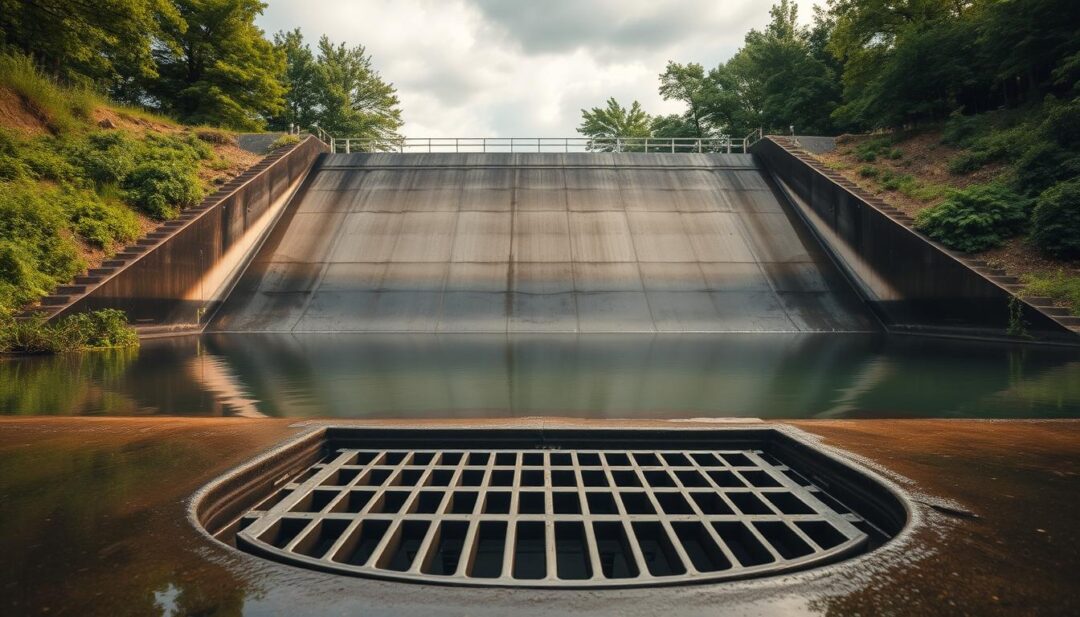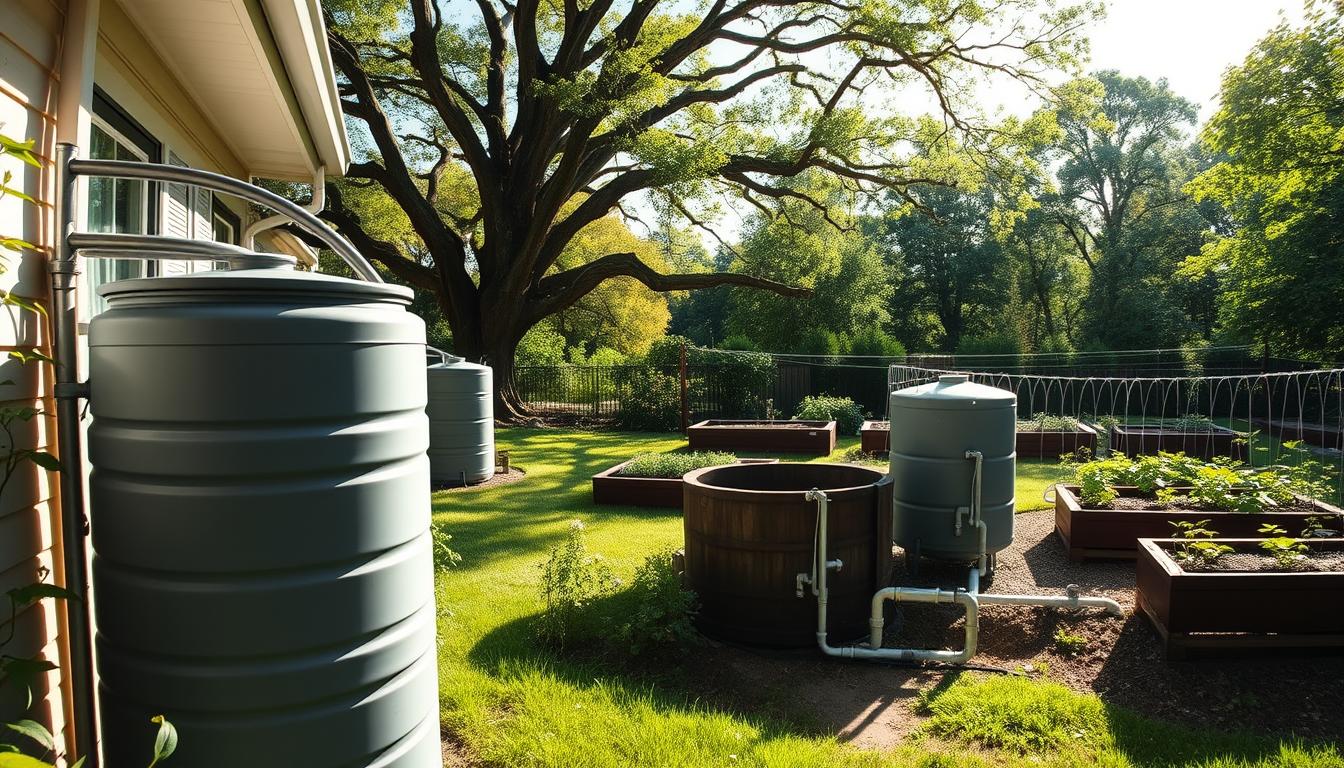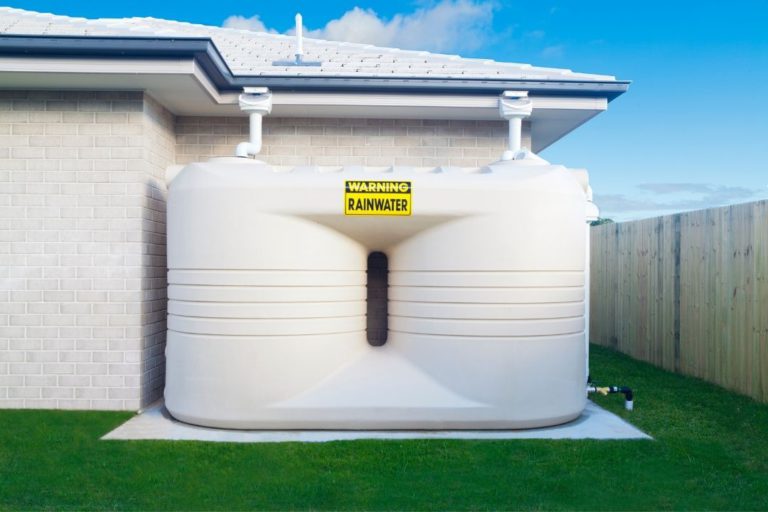Discover the 7 Rainwater Harvesting Methods
As the world grapples with the challenges of climate change and water scarcity, sustainable water solutions have become more crucial than ever. One effective way to conserve water is through rainwater harvesting. But can this ancient practice be adapted to meet the needs of modern communities?
By exploring the 7 rainwater harvesting methods, individuals can choose the best approach for their specific needs, whether it’s for a residential, commercial, or industrial setting. This article will delve into the various rainwater harvesting systems available, providing a comprehensive guide to help you make an informed decision.
Key Takeaways
- Understanding the importance of rainwater harvesting for water conservation
- Exploring the different rainwater harvesting methods available
- Learning how to choose the best rainwater harvesting system for your needs
- Discovering the benefits of implementing rainwater harvesting
- Gaining insights into the various applications of rainwater harvesting
The Growing Importance of Rainwater Harvesting
With water scarcity becoming a pressing issue globally, the need to adopt effective rainwater harvesting methods has never been more critical. As the demand for water continues to grow, the United States faces significant challenges in meeting its water needs, particularly in regions prone to drought.
Water Scarcity Challenges in the United States
The United States is experiencing a surge in water scarcity due to factors such as climate change, population growth, and aging infrastructure. States like California and Texas have faced severe droughts, highlighting the need for sustainable water management practices. Rainwater harvesting offers a viable solution by collecting and storing rainwater for various uses, thereby reducing the strain on traditional water sources.
Environmental Benefits of Capturing Rainwater
Capturing rainwater not only helps alleviate water scarcity but also provides several environmental benefits. By reducing stormwater runoff, rainwater harvesting can minimize the risk of flooding and erosion in urban areas. Additionally, it can help recharge groundwater aquifers, supporting local ecosystems and maintaining water tables.
The benefits of rainwater harvesting extend to reducing the energy required to treat and transport water, as well as decreasing the burden on municipal water supplies. As communities adopt rainwater harvesting practices, they can contribute to a more sustainable water future.
What Are the Seven Types of Rainwater Harvesting?
Rainwater harvesting encompasses a range of methods, from traditional to modern, each with its unique benefits. This diversity allows individuals and communities to choose the most suitable technique based on their specific needs and environmental conditions.
Overview of Traditional and Modern Approaches
Traditional rainwater harvesting methods include simple techniques such as using barrels or tanks to collect rainwater from rooftops. These methods have been effective for small-scale water collection. Modern approaches, however, have evolved to include more sophisticated systems like rainwater tanks with filtration systems and permeable pavements that allow for larger-scale collection and improved water quality.
The integration of technology has enhanced the efficiency and safety of rainwater harvesting. For instance, modern systems can include first flush devices that divert the initial flow of water from the roof, potentially contaminated with debris, away from the storage tank, thus improving the overall quality of the harvested water.
Selecting the Right Method for Your Needs
When choosing a rainwater harvesting method, several factors should be considered, including the available space, budget, and intended use of the collected water. For example, households might opt for rooftop collection systems or rain barrels, while larger establishments might require more complex systems like underground cisterns.
It’s also crucial to consider the local regulations and climate. Some regions may have specific guidelines or restrictions on rainwater harvesting. Understanding these factors will help in selecting a method that is not only effective but also compliant with local laws.
Rooftop Rainwater Collection Systems
Rooftop rainwater harvesting is an efficient method for collecting and storing rainwater for various uses. This method has gained popularity due to its simplicity and effectiveness in conserving water.
Components of a Complete Rooftop System
A complete rooftop rainwater harvesting system consists of several key components. These include a catchment area (typically the roof), a conveyance system (gutters and downspouts), and a storage tank. The catchment area should be clean and free of contaminants to ensure the quality of the harvested rainwater.
The conveyance system directs the rainwater from the roof to the storage tank. It’s crucial to ensure that gutters and downspouts are properly sized and maintained to handle the rainfall runoff.
- Catchment area (roof)
- Conveyance system (gutters and downspouts)
- Storage tank
- First flush device (optional)
Installation Process and Requirements
Installing a rooftop rainwater harvesting system requires careful planning and execution. The process involves assessing the roof’s suitability, sizing the storage tank appropriately, and ensuring that the conveyance system is properly installed.
| Installation Step | Description |
|---|---|
| Roof Assessment | Evaluate the roof’s material, size, and condition. |
| Tank Sizing | Determine the appropriate size based on rainfall data and intended use. |
| Conveyance System Installation | Install gutters and downspouts to direct rainwater to the storage tank. |
Maintenance and Longevity Considerations
Regular maintenance is crucial for the longevity and effectiveness of a rooftop rainwater harvesting system. This includes inspecting the catchment area, cleaning gutters, and checking the storage tank for sediment buildup.
“Regular maintenance of rainwater harvesting systems ensures their longevity and effectiveness in conserving water.”
By understanding the components, installation process, and maintenance needs of rooftop rainwater collection systems, individuals can effectively implement this water conservation method.
Rain Barrels: Simple and Effective Harvesting
Rain barrels offer a straightforward and efficient method for harvesting rainwater, making them an ideal starting point for individuals new to rainwater collection. By installing a rain barrel, homeowners can easily collect and store rainwater for various non-potable uses, such as watering plants or washing cars.

DIY vs. Commercial Rain Barrel Options
When it comes to rain barrels, homeowners have the option to either purchase a commercial product or create their own DIY solution. Commercial rain barrels are readily available and come with features like built-in screens and spigots, making them a convenient choice. On the other hand, DIY rain barrels can be a cost-effective alternative, allowing individuals to repurpose old containers or barrels.
Setting Up Your First Rain Barrel System
Setting up a rain barrel system is relatively simple. First, select a suitable location for your barrel, ideally under a downspout to maximize collection. Ensure the barrel is level and securely positioned. Then, connect the downspout to the barrel using a diverter, and add a spigot for easy water access.
Maximizing Storage with Multiple Barrels
For those with higher water storage needs, using multiple rain barrels can be an effective solution. By connecting several barrels together, homeowners can significantly increase their rainwater storage capacity. This approach allows for greater flexibility and can be particularly useful for larger gardens or households.
Rainwater Tanks and Cisterns
When it comes to storing harvested rainwater, tanks and cisterns are the most practical solutions. These storage systems come in various sizes and types, catering to different needs and spaces.
Above-Ground vs. Underground Storage Options
One of the primary decisions when selecting a rainwater tank is whether to install it above-ground or underground. Above-ground tanks are generally easier and less expensive to install, making them a popular choice for many homeowners. On the other hand, underground tanks offer a more aesthetically pleasing solution, as they are hidden from view, and can be particularly useful in areas with limited space.
The choice between above-ground and underground storage also depends on local regulations and the intended use of the harvested water. For example, underground tanks might be preferred for larger-scale agricultural or industrial applications.
Material Choices and Durability Factors
The material of the tank is another crucial consideration. Common materials include plastic, steel, and concrete. Each material has its pros and cons in terms of durability, cost, and maintenance. For instance, plastic tanks are lightweight and resistant to corrosion, while steel tanks offer greater strength but may require additional coating to prevent rust.
Sizing Your Tank for Optimal Collection
Sizing the tank correctly is vital to ensure it can hold enough rainwater to meet your needs without being too large for the available space. Factors to consider include the size of your roof, the average rainfall in your area, and your intended use of the harvested water. A professional can help determine the optimal size based on these factors.
By carefully considering these elements, you can maximize the efficiency of your rainwater harvesting system.
Rain Gardens: Natural Filtration Systems
Rain gardens serve as a natural filtration system, improving water quality and reducing stormwater drainage burdens. These gardens are depressions in the ground that collect and filter rainwater, allowing it to slowly infiltrate the soil. By doing so, they not only reduce the amount of stormwater runoff but also provide a habitat for various plants and wildlife.
Designing an effective rain garden requires careful consideration of several factors.
Designing an Effective Rain Garden Layout
To create a successful rain garden, it’s essential to choose a location that receives the right amount of rainfall and is visible from your house to enjoy. The size and shape can vary, but it should be proportionate to your yard. A well-designed layout also considers the slope and soil type to maximize water absorption.
Plant Selection for Maximum Absorption
Selecting the right plants is crucial for the effectiveness of a rain garden. Plants native to your region are ideal because they are adapted to local rainfall patterns and soil conditions. Deep-rooted plants like perennials and shrubs are particularly effective at absorbing water and stabilizing the soil.
By incorporating rain gardens into your landscaping, you can create a beautiful and functional outdoor space that also benefits the environment. Rain gardens are a simple yet effective way to manage rainwater runoff, improve water quality, and enhance biodiversity.
Permeable Surfaces and Infiltration Methods
Permeable surfaces and infiltration methods are revolutionizing the way we manage rainwater runoff. By adopting these sustainable drainage solutions, individuals can significantly reduce stormwater runoff, recharge groundwater, and mitigate the risk of flooding.
Permeable Pavement Types and Applications
Permeable pavement is a crucial component of permeable surfaces, allowing rainwater to infiltrate through the surface into the ground below. There are several types of permeable pavement, including:
- Porous asphalt
- Permeable interlocking concrete pavers
- Permeable concrete
These pavement types can be applied in various settings, such as driveways, walkways, and parking lots, providing a durable and sustainable alternative to traditional impermeable surfaces.
French Drains and Dry Wells Implementation
French drains and dry wells are effective infiltration methods used to manage rainwater runoff. A French drain is a trench filled with gravel and a perforated pipe that redirects water to a suitable outlet. Dry wells, on the other hand, are structures that allow rainwater to infiltrate into the ground.
Key benefits of French drains and dry wells include:
- Reduced stormwater runoff
- Recharge of groundwater
- Mitigation of flooding risk
By implementing these infiltration methods, individuals can create a more sustainable and resilient drainage system.
Stormwater Detention Systems
The importance of stormwater detention systems cannot be overstated in modern urban water management. These systems play a vital role in managing large-scale rainwater collection and reducing the impact of stormwater runoff.
Stormwater detention systems are designed to capture and temporarily hold stormwater runoff, slowly releasing it to prevent overwhelming urban drainage systems. This not only helps in preventing flooding but also aids in improving water quality by allowing sediments to settle.
Large-Scale Collection Approaches
Large-scale stormwater detention systems are engineered to handle significant amounts of rainfall. These systems can include:
- Detention ponds that temporarily hold water
- Underground storage tanks for large volumes
- Infiltration basins that allow water to seep into the ground
These approaches are crucial for managing stormwater in urban areas where impervious surfaces are prevalent.

Community and Municipal Applications
Stormwater detention systems have numerous applications in community and municipal settings. They are used to:
- Protect communities from flooding by managing stormwater runoff
- Enhance water quality by reducing sediment and pollutant loads
- Recharge groundwater through infiltration
By implementing these systems, municipalities can significantly reduce the risk of urban flooding and improve overall water management.
Effective stormwater detention is a key component of sustainable urban planning, offering a proactive approach to managing rainwater and mitigating its impact on urban infrastructure.
Water Quality and Treatment for Harvested Rainwater
Water quality is a critical factor in determining the usability of harvested rainwater. Ensuring that the collected rainwater is free from contaminants is essential for its safe and effective use.
Different end uses require different levels of water treatment. For irrigation and toilet flushing, basic filtration may suffice. However, for drinking water, more advanced treatment methods are necessary.
Filtration Methods for Different End Uses
Various filtration methods can be employed based on the intended use of the harvested rainwater. For non-potable purposes, sedimentation and basic filtration are often adequate. For potable use, additional treatments such as UV disinfection or reverse osmosis may be required.
Ensuring Safe Drinking Water Standards
To meet safe drinking water standards, harvested rainwater must undergo rigorous treatment and testing. This includes removing pathogens, heavy metals, and other contaminants. Regular maintenance of the collection and treatment systems is also crucial.
Conclusion: Making Every Drop Count
As we’ve explored the various rainwater harvesting methods, it’s clear that adopting sustainable water solutions is crucial for a water-conscious future. From rooftop collection systems to rain gardens, each method offers a unique way to conserve water and reduce our environmental footprint.
Understanding how to collect rainwater effectively is the first step towards making a positive impact. By implementing these systems, individuals can significantly contribute to the importance of rainwater harvesting, helping to alleviate water scarcity challenges and promote eco-friendly practices.
As we move forward, it’s essential to recognize the role we play in shaping a more sustainable tomorrow. By embracing rainwater harvesting and other water-saving strategies, we can create a ripple effect that benefits both our communities and the environment. Start your rainwater harvesting journey today and join the movement towards a more water-resilient future.







